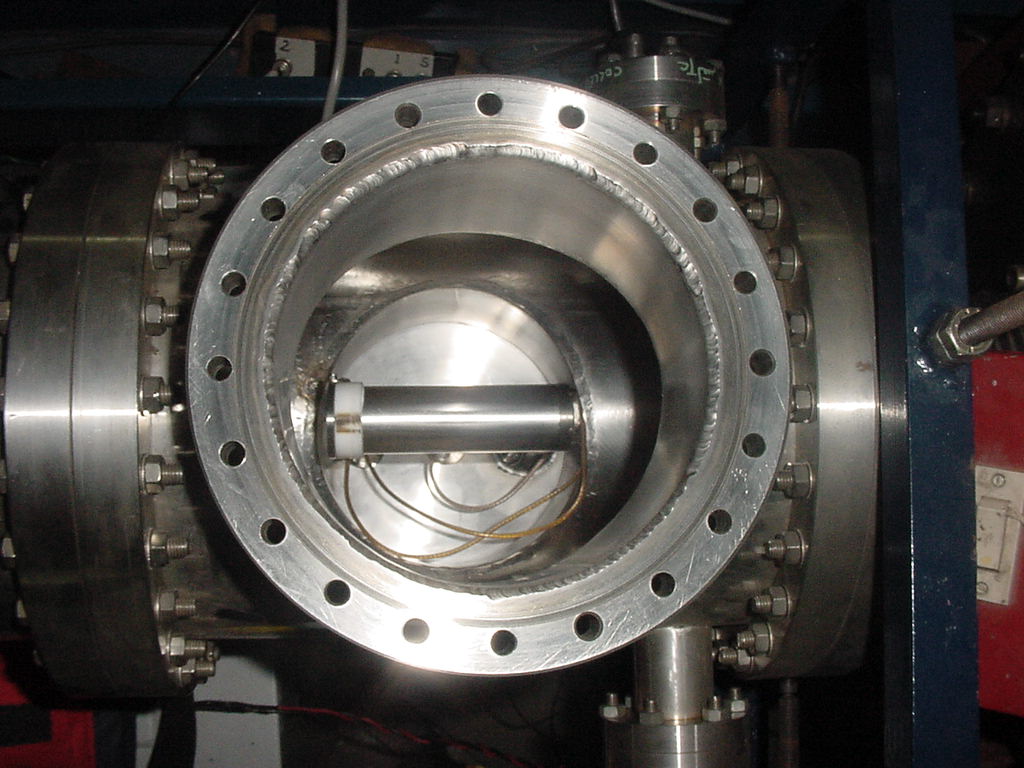
 |
|||
| About AMS | Features | Facilities | Group Members | Related Links | Future Plans | Queries | Users |
 Multi Cathode Source of Negative Ion by Cs Sputtering (MC-SNICS) |
Multi-Cathode SNICSMulti-Cathode Source of Negative Ion by Cs Sputtering (MC-SNICS) is capable of holding 40 cathodes. Cathode holder can be rotated in both ways from control room. Bidirectional motion and quick change of cathodes is necessary in AMS measurement for changing standard and AMS sample quickly to neglect accelerator parameter variation effect between different measurements. |
 Re-circulating turbo pumps for gas stripper |
Re-circulating Gas StripperIUAC Pelletron facility is equipped with foil stripper and gas stripper assembly. For AMS studies, transmission through the accelerator should be optimum. Gas stripper produces less divergence after stripping compared to foil stripper. Transmission also reduces by scattering of beam by gas molecules in accelerating tubes. So good vacuum should be maintained in these tubes. Therefore a new re-circulating turbo molecular pump - based pumping system has been designed and installed in the high - voltage terminal of the accelerator. This helps in improving beam transmission by maintaining good vacuum in the accelerating tubes while holding required gas pressures in the stripping area. |
 Offset Faraday Cup situated after Analyser magnet ( Top View) |
Off-Set Faraday CupOff-Set Faraday is installed after the analyser magnet. It is used to count stable isotopes which follows different trajectory after passing through analyser magnet in the case of simultaneous injection of both isotopes. |
 Wien Filter |
Wien FilterStripping can also happen at the places other than terminal by residual gas molecules inside the accelerating tube. These ions may not have the assumed value of kinetic energy T and accidentally can match the MT/q2 and can not be rejected by the analyser magnet. Stable isotope can also come by scattering off chamber walls of the magnet or residual gas molecules, because they are much more abundant. All these unwanted entities can be separated by the Wien filter (T/M selection). |
 Beam Hall 1 part of IUAC- AMS beam line |
Detection SetupAMS ChamberAMS chamber is equipped with remote controlled ladder (containing solid state detector and quartz), insertable Faraday cup, and view ports. Insertable Faraday CupInsertable Faraday cup is used for measuring the current of stable isotope. In case of AMS measurement of 14C, 36Cl, and 26Al, insertable Faraday cup will be used to measure the current produced by 12C/ 13C, 35Cl/ 37Cl and 27Al stable ions respectively. Gas Cell AbsorberGas cell Absorber is installed after the AMS Chamber and before the MAGIC detector. It is used for stopping 10B, the isobar of 10Be before detector. Gas cell absorber and AMS chamber is separated by 6 micro meter myler. For absorbing 40MeV 10B, 220 milli bar pressure of N2gas is required in gas cell absorber. Multi-Anode Gas Ionization Chamber (MAGIC)Multi - Anode Gas Ionization Detector is used to count rare isotopes after identification as having correct Z (atomic no.) and M (mass). IUAC MAGIC Detector system consists of 5 sections of anode(2cm, 5cm, 5cm, 5cm, 10.6 cm having 1 mm gap from each other), one cathode and frisch grid. The frisch grid is kept at ground potential. It is used to ensure that the size of the induced pulse on the anodes is independent of lateral position of ionization event inside the detector.All the feed through connections are taken on the back flange of the detector through LEMO sockets. On the front flange of detector, myler window of 6 micro meter thickness is present for holding the gas inside the detector and to slow down some impurities. |
 Clean Chemistry Laboratory |
Clean Chemistry LaboratoryIn AMS the isotope of interest is filtered (separated) from interfering isotopes at various levels. Chemical processing is the first filtering stage. During this stage the isotope of interest is separated from various elements present in the sample and converted in a suitable chemical form to produce high ion yield from the ion source. Chemical processing of sample also provide uniform matrix for analysis and reduces the mass of sample to be put in the ion source and thereby reduces the time needed to attain a given level of precision. Sometimes specific chemical form of the radionuclide reduces isobaric background. |